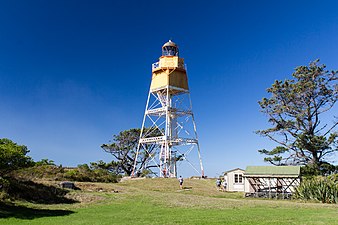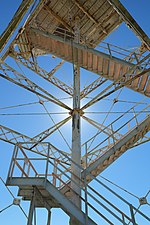Lighthouse
 | |
| Location | Farewell Spit, Tasman District, New Zealand |
|---|---|
| Coordinates | 40°32′46″S 173°00′34″E / 40.54604°S 173.00938°E / -40.54604; 173.00938 |
| Tower | |
| Constructed | 1896 |
| Construction | metal (artificial physical structure) |
| Automated | 1984 |
| Height | 27 m (89 ft) |
| Markings | grey (tower), orange (top) |
| Power source | solar power |
| Light | |
| First lit | 19 January 1897 |
| Focal height | 30 m (98 ft) |
| Lens | second order Fresnel lens |
| Light source | rotating LED beacon |
| Range | 19 nmi (35 km; 22 mi) (red) |
| Characteristic | Fl WR 15s |
| Original lighthouse | |
 | |
| Constructed | 1870 |
| Construction | lumber |
| Height | 34.4 m (113 ft) |
| Markings | white (tower) |
| First lit | 17 June 1870 |
| Deactivated | 17 January 1897 |
| Focal height | 36.6 m (120 ft) |
| Lens | second order Fresnel lens |
| Range | 17 nmi (31 km; 20 mi) |
| Characteristic | Fl WR 60s |
The Farewell Spit Lighthouse is located at the end of New Zealand's longest sand spit in Golden Bay / Mohua, near the northern tip of the South Island. It guides vessels entering Cook Strait from the west and south. The LED rotating beacon flashes white or red, once every 15 seconds. It has a range of 19 nautical miles (35 km; 22 mi). Red is shown to warn approaching vessels of extensive shoaling. Standing 27 metres (89 ft) tall, the tower needs to be taller than the support structures of most lighthouses built on cliffs or headlands, because the sand foundations it is built upon are almost at sea level. The tower is constructed of an open steel lattice to withstand abrasive sand and salt-laden winds.
History
The drifting sand dunes of Farewell Spit are low lying and interspersed with fresh water lagoons, with an extensive shoal area on the southern side. The need for a lighthouse to warn mariners was identified in 1856, in the days of early European settlement, in response to a growing number of stranding and wrecks. An initial proposal was made for a floating lighthouse, moored 2 miles (3.2 km) off the end of the spit. In 1866, there were protests about government delays in establishing a lighthouse on Farewell Spit. Eventually, under the direction of James Balfour, Colonial Marine Engineer and Superintendent of Lighthouses, a design was prepared for a lighthouse to be built at Bush End Point, near the end of the sandspit. The first lighthouse was constructed on a wooden lattice tower in 1870. However, it was no match for the abrasive sand and salt-laden winds. Tenders were called in December 1894 for a replacement steel lattice tower, and a new lighthouse was commissioned in January 1897.
The original oil-burning lamp was converted to a 1000-watt electric lamp in 1954, and the diesel power supply replaced by a buried mains electricity cable along the spit in 1966. The original lamp was changed to a modern rotating beacon with a 50-watt tungsten halogen bulb in 1999. In 2019, the lighthouse was converted to solar power, and the mains supply disconnected.
The spit was a barren and uninviting place to be a lighthouse keeper. Sand got into everything. The lighthouse sits on a low vegetated dune; an oasis surrounded by an ever-changing landscape, reshaped by incessant wind and tide. Early attempts at gardening were swamped during exceptional high tides, or plants were eaten by marauding weka.
Since being de-manned and automated in 1984, the keeper’s houses are used by the Department of Conservation and tour groups.
The keepers include:
- Alexander Greenlees McKinlay (2nd assistant, 1871–1872)
- James Nelson (c. 1870s)
- Robert Leighton (c. 1916)
- Hugh Jamieson (1946–1949)
In 2016, structural repairs were made to the tower and it was given a major repaint. All materials for the work, including 10 storeys of scaffolding, paint, and the water required for blasting and surface preparation had to be transported along the sandspit to the site.
Access
The lighthouse is located approximately 27 kilometres (17 mi) along the sand spit. Farewell Spit / Onetahua is a wildlife sanctuary run by the Department of Conservation. The area is an important bird nesting area, especially for Australasian gannet. It is closed to casual visitors, and public access to the lighthouse site is restricted to people on an ecotour. The public is not permitted to climb the lighthouse structure.
Operations
The lighthouse is operated by Maritime New Zealand. With a focal height of 30 metres (98 ft) above sea level, the light can be seen for 19 nautical miles (35 km; 22 mi). Its characteristic is either a white or red flash every fifteen seconds, depending on where you view it from. It is a sector light. The red flashes warn a vessel it is in a danger of hitting the shoal. The white sector shines from 113° to 299° and 333° to 110°; the red from 299° to 333°.
Depiction on postage stamps
The Farewell Spit Lighthouse was featured on a 10-cent postage stamp issued in 1969 in conjunction with the centenary of the New Zealand Government Life Insurance Office.
Gallery
References
- Rowlett, Russ. "Lighthouses of New Zealand: South Island". The Lighthouse Directory. University of North Carolina at Chapel Hill. Retrieved 3 June 2022.
- ^ "Farewell Spit lighthouse – Maritime NZ". www.maritimenz.govt.nz. Archived from the original on 9 June 2022. Retrieved 3 June 2022.
- Hydrographic Department, Great Britain (2001). New Zealand Pilot. Taunton, England: Hydrographer of the Navy. ISBN 0707712912.
- ^ Petyt, Chris (1999). Farewell Spit a Changing Landscape: History and Natural History. Takaka, N.Z.: Terracottage Books. pp. 54, 63. ISBN 0473055392.
- "Untitled". Nelson Evening Mail. 23 August 1866. Retrieved 5 February 2023 – via Papers Past.
- "The postal and lighthouse questions". Nelson Examiner and New Zealand Chronicle. 19 June 1866. Retrieved 5 February 2023 – via Papers Past.
- Newport, J. N. W. (November 1971). "Farewell Spit Lighthouse". Nelson Historical Society Journal. 1 (5): 7–8. Archived from the original on 20 April 2022. Retrieved 4 June 2022.
- "Wrought iron tower contract – Farewell Spit Lighthouse". Grey River Argus. 1 December 1894. Retrieved 2 February 2023 – via Papers Past.
- History of the lighthouse (Information panel at the lighthouse keeper's house). Bush-end Point: Maritime New Zealand.
- ^ Nalder, Guinevere (December 2007). Southern Lights - The Scottish Contribution to New Zealand's Lighthouses. Dunbeath: Whittles Publishing Ltd. ISBN 978-1-84995-156-2. Wikidata Q112554192.
- The Long Sweeping Sand Spit (Interpretation panel Port Pūponga, at base of the spit). Fossil Point: Department of Conservation. 2016.
- "Farewell Spit Tours discover lighthouse". Farewell Spit Tours. 2022. Archived from the original on 26 January 2022. Retrieved 3 June 2022.
- "Lighthouse Explorer". Lighthouse Digest Magazine. Archived from the original on 16 October 2018. Retrieved 4 June 2022.
- Leov, Tasha (8 June 2016). "Farewell Spit Lighthouse shows off new face". Stuff. Retrieved 27 January 2023.
- "Farewell Spit Lighthouse". Farewell Spit Tours. Retrieved 28 January 2023.
- Marine Division, Ministry of Transport, New Zealand Nautical Adviser (2022). New Zealand nautical almanac. Wellington, N.Z.: Land Information New Zealand.
- "K4182 Cape Farewell / Farewell Spit Bush-end Point". Online list of lights. Archived from the original on 29 September 2022. Retrieved 4 June 2022.
- "Farewell Spit (South Island) Light ARLHS NZL-022". List of the world's lighthouses by the Amateur Radio Lighthouse Society. Archived from the original on 3 June 2022. Retrieved 4 June 2022.
- "1969 Lighthouses – Centenary of the New Zealand Government Life Insurance Office". stampsnz.com. Retrieved 29 January 2023.




